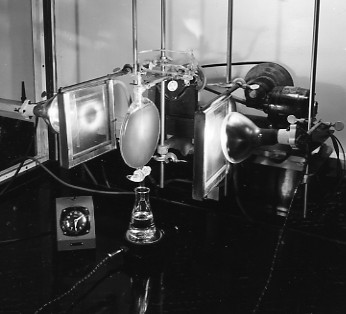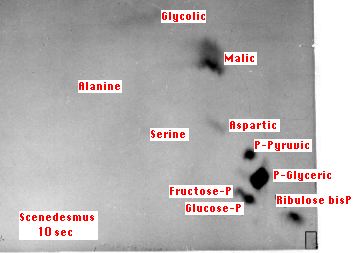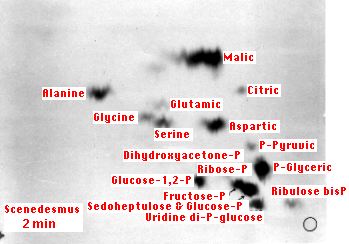
Photosynthesis is the synthesis of organic molecules using the energy of light. For the sugar glucose (one of the most abundant products of photosynthesis) the equation is:
6CO2 + 12H2O -> C6H12O6 + 6H2O + 6O2
A description of the experiments that led to this equation are described in Discovering the Secrets of Photosynthesis.
Light provides the energy to:The details of these processes are described in Photosynthesis: The Role of Light.
ATP and NADPH provide the energy and electrons to reduce carbon dioxide (CO2) to organic molecules.

The graphic shows the steps in the fixation of carbon dioxide during photosynthesis. All of these reactions occur in the stroma of the chloroplast.
| Link to chloroplasts |
These steps were worked out by Melvin Calvin and his colleagues at the University of California and, for this reason, are named the Calvin cycle.
 |
| Apparatus used to follow the fate of 14CO2 in the dark reactions. The algal suspension is placed in the "lollypop", supplied with 14CO2, and illuminated. The dark reactions are halted by draining the contents of the lollypop into a flask of hot alcohol. (Courtesy of Dr. James A. Bassham.) |
The experimental apparatus is shown at the right. After various intervals of illumination, a suspension of unicellular algae is inactivated and the contents of the cells extracted. The compounds in a drop of the extract are then separated by paper chromatography.
The identity of each substance may be determined simply by comparing its position with the positions occupied by known substances under the same conditions. Or, a fragment containing the spot can be cut from the sheet and chemically analyzed.
To determine which, if any, of the substances separated on the chromatogram are radioactive, a sheet of x-ray film is placed next to the chromatogram. If dark spots appear on the film (because of radiation emitted by the 14C atoms), their position can be correlated with the positions of the chemicals in the chromatogram. Using this technique of autoradiography, Calvin found that 14C turned up in glucose molecules within 30 seconds after the start of photosynthesis. When he permitted photosynthesis to proceed for only 5 seconds, however, the radioactivity was concentrated in several other, smaller, molecules.
 |  |
| The dark spots show the radioactive compounds produced after 10 secs (left) and 2 minutes (right) of photosynthesis by the green alga Scenedesmus. The alga was supplied with carbon dioxide labeled with 14C, a radioactive isotope of carbon. At 10 seconds, most of the radioactivity is found in 3-phosphoglyceric acid ("P-Glyceric"). At 2 minutes, phosphorylated 6-carbon sugars (glucose and fructose) have been synthesized as well as a number of amino acids. The small rectangle and circle (lower right-hand corners) mark the spots where the cell extract was applied. (Courtesy of Dr. James A. Bassham.) | |
| Link to discussion of the free energy changes in photosynthesis. |
| Because CO2 enters the Calvin cycle as the 3-carbon molecule 3-phosphoglyceric acid, this type of photosynthesis is called C3 photosynthesis. However, some plants have an additional method of carbon fixation called C4 photosynthesis. This is discussed on a separate page. Link to it. |
| Welcome&Next Search |